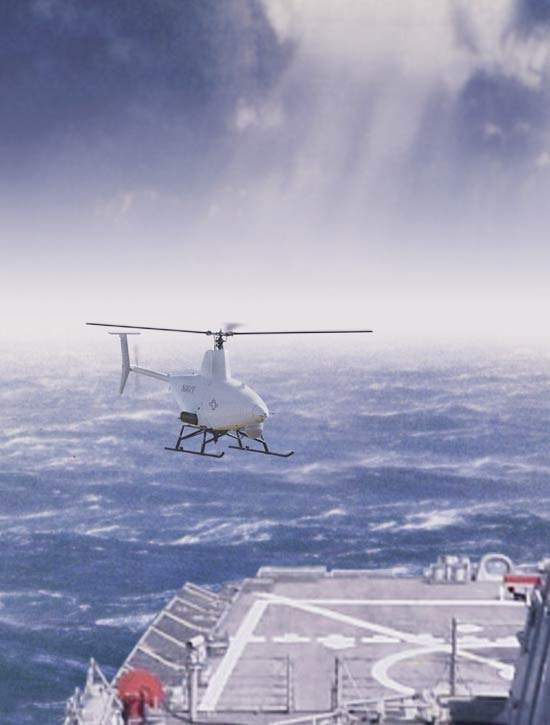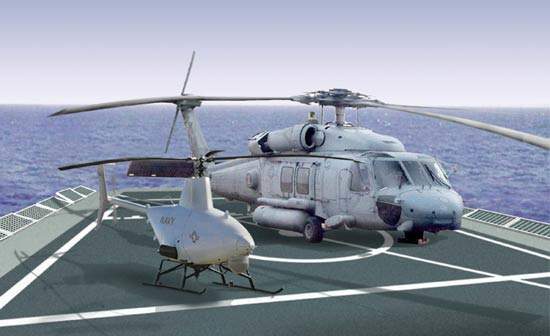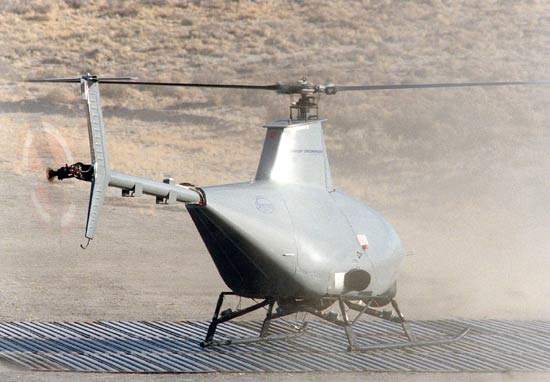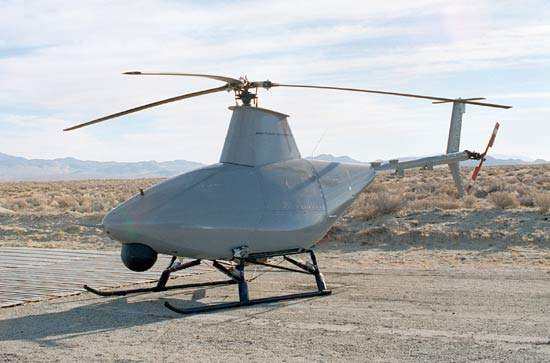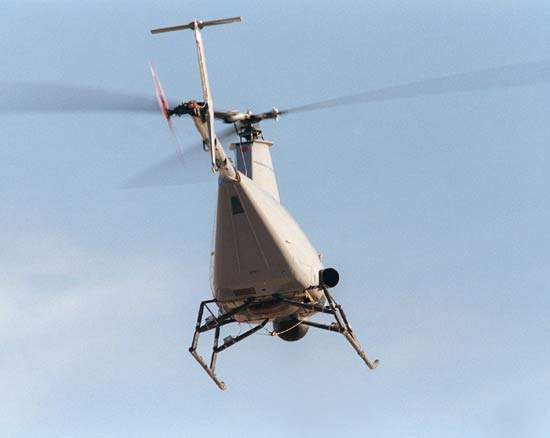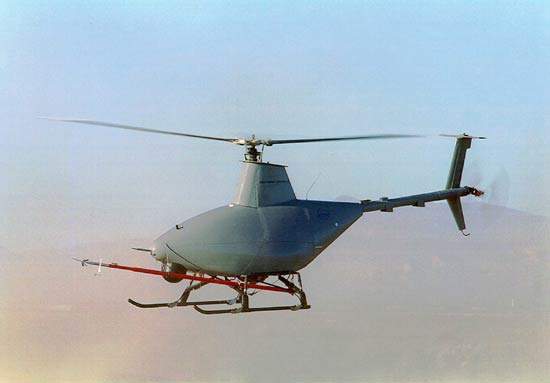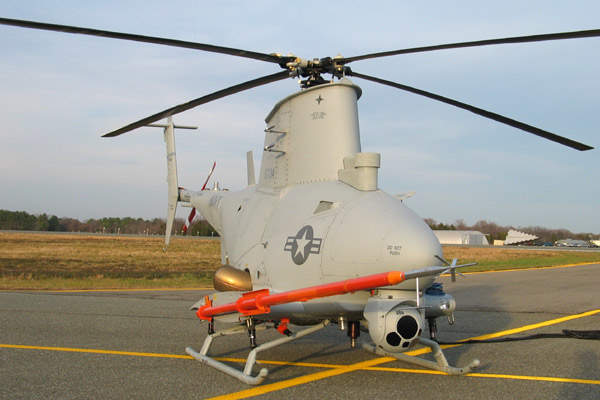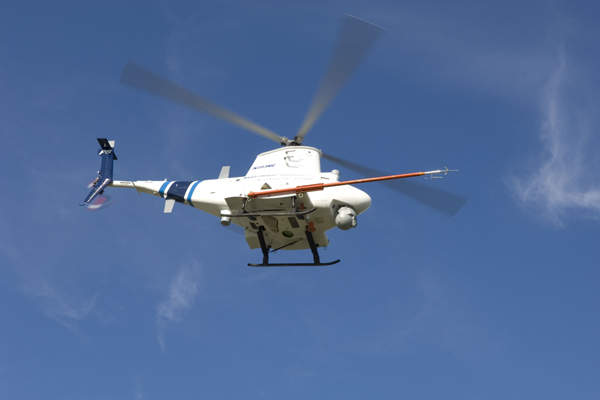In February 2000, the US Navy chose the RQ-8A Fire Scout as its vertical take-off and landing tactical unmanned air vehicle (VTUAV). Northrop Grumman-Ryan Aeronautical of San Diego was awarded an engineering and manufacturing development (EMD) contract for the Fire Scout, which would provide situational awareness and precision targeting support to the US Navy and Marine Corps. The Fire Scout programme is being managed by the US Navy’s PMA-263 Unmanned Vehicles Program Office at Patuxent River, Maryland.
In August 2005, Fire Scout was redesignated from RQ-8 to MQ-8 to reflect its multirole capability, including the ability to deploy weapons.
Fire Scout has the ability to autonomously take-off from and land on any aviation-capable warship and also at unprepared landing zones close to the forward edge of the battle area (FEBA). It can carry out surveillance, find tactical targets, track and designate targets and provide accurate targeting data to strike platforms such as strike aircraft, helicopters and ships. The UAV is also able to carry out battle damage assessment. The navy is currently using the Pioneer UAV and has 21 Pioneer systems operational on its ships.
Fire Scout entered low-rate initial production (LRIP) in May 2001. The LRIP system includes three air vehicles, two ground control stations, a datalink suite, remote data terminals and modular mission payloads.
In January 2002, the US Department of Defense decided not to allocate funding for Fire Scout after the completion and testing of the LRIP systems. The final LRIP vehicle was delivered in June 2003. Shipboard testing during August and September 2003, onboard Austin Class LPD (landing platform dock) USS Denver included take-off and landings using the common automatic recovery system and the Raytheon tactical control system.
In September 2003, an enhanced version of Fire Scout, MQ-8B, was chosen for the Class IV-A brigade level UAV element of the US Army’s future combat system (FCS). The SDD (system development and demonstration) contract was awarded in January 2004 and requires the production of seven air vehicles. The MQ-8B has a four-bladed rotor, increased payload capacity to 270kg and more than eight-hour endurance with a 90kg payload. The payload includes reconnaissance, surveillance and target acquisition (RSTA) and target designation capability. The first flight of the army variant is scheduled for February 2011 with initial operating capability in 2015.
In March 2004, the US Navy placed a contract with Northrop Grumman for the development of the MQ-8B Fire Scout for deployment on the new littoral combat ships (LCS). Nine air vehicles are to be produced under the system development and demonstration contract, to complete in 2009. MQ-8B entered low-rate initial production (LRIP) in May 2007.
As scheduled, the technical and operational evaluation (OPEVAL) started in 2009. Due to delays in the LCS development schedule, the USN plans to conduct sea trials, OPEVAL and initial deployment on board USS McInerney, Oliver Hazard Perry Class frigate. Initial operating capability for the MQ-8B is planned for autumn 2009.
MQ-8B air vehicles are common for the US Army and Navy but the payload differs. Baseline payload for the USN includes the FLIR Systems AN/AAQ-22D BriteStar II target designation system with electro-optical and infrared sensors and a laser range finder / designator.
In January 2006, Northrop Grumman received the first MQ-8B airframe from Schweizer. The first flight of the MQ-8B was in December 2006, at Patuxent River Naval Air Station. There are 15 MQ-8B on order for the US Army and nine for the Navy.
Northrop Grumman is carrying out a weapons integration programme which includes the installation of two four-packs of 2.75in rocket launchers on the air vehicle. The launchers are designed to fire advanced precision kill weapon system laser-guided rockets. In July 2005, Fire Scout successfully fired two 2.75in mk66 unguided rockets.
In March 2006, for a programme called “beyond line-of-sight tactical UAV communications relay” (BTCR), Fire Scout successfully demonstrated that a tactical UAV can be used to enable over-the-horizon communications relay, allowing ground troops on the move and battlefield commanders to share uninterrupted voice, data and real-time video.
In January 2008, Northrop Grumman initiated the important phase of the MQ-8B Fire Scout development with the first flight test using a test and training control segment. This is a shelterised version of the exact consoles and other equipment being integrated into littoral combat ships (LCS) for operational use of the MQ-8B Fire Scout.
In a bid to make MQ-8B Fire Scout more efficient, the company demonstrated radar capability in September the same year. The sole aim was to search, detect, and track multiple targets during a test surveillance mission. Towards the end of the year, US Navy’s Naval Air Systems Command awarded the company with a $32.9m second year LRIP contract.
After a thorough study, in December 2008, the company demonstrated continuous combined payload coverage on its MQ-8B Fire Scout. The effort was to reduce risk and solidify requirements for Fire Scout’s multiple radar integration programmes.
The company witnessed the Fire Scout programme much closer to operational evaluation (OpEval) status, with VTUAV completed fully autonomous flight operations onboard the USS McInerney (FFG-8) frigate in the early part of May 2009. These operations noted that the navy, for the first time, operated an autonomous VTUAV aboard a surface combatant vessel. This followed at-sea operations aboard the USS Nashville (LPD-13), which included the first autonomous ship landing by an US Navy unmanned aerial vehicle (UAV).
In May 2009, Northrop Grumman developed the MQ-8B Fire Scout VTUAV with the latest set of fully autonomous flight operations onboard the USS McInerney (FFG-8) in support of dynamic interface testing.
Helicopter air vehicle
The Fire Scout air vehicle is a Schweitzer 333 helicopter based on the proven design of the Schweitzer 330 commercial lightweight manned utility helicopter. A benefit of selecting the commercially available design is that Schweitzer company based in Elmira, New York has an established worldwide spares and support infrastructure.
The air vehicle has a folded length of just less than 23ft. The three-bladed rotor has a diameter of 27ft 6in and the vehicle stands 9ft 5in high. The gross weight is 2,550lbs. The vehicle has an endurance greater than six hours, providing a loiter time of more than four hours at a combat radius of 110nm.
Schweitzer has developed a four-bladed rotor hub for the MQ-8B, which extends the UAV’s range, payload and endurance. First flight of the upgraded vehicle was in April 2003. The upgrade requires no major structural or mechanical changes to the airframe.
The Schweitzer 330 uses a Rolls-Royce Allison C250 engine generating 480shp. The engine provides a maximum speed of more than 125kt and a flight ceiling of 20,000ft. It has the ability to fly 110nm from launch site, loiter up to four hours and return to base. In addition, the vehicle endurance is greater than seven hours and it has laser designator to find tactical targets.
Ground control
The system includes advanced ground control facilities including the US Navy’s tactical control station (TCS), developed by Raytheon for installation on Navy ships, and the forward deployed Marine Corps’ portable ground station, tactical datalinks and communications networks.
The Navy UAV carries a L-3 Communications tactical common datalink (TCDL) terminal. The Ku-band datalink has a narrow band uplink for vehicle and payload control and a wide band downlink for digital streaming video and data from the payload. Other ground control elements include four Rockwell Collins AN/ARC-210 radio systems and Sierra Nevada Corporations UAV common automatic recovery system.
Modular payload design
The system is designed to accommodate modular payloads to suit evolving operational requirements. The RQ-8A air vehicle has been fitted with a UAV multimission optronic stabilised payload (UMOSP) developed by Israel Aircraft Industries’ Tamam Division with electro-optical sensors including infrared imager and a laser rangefinder / designator.
In March 2008, the US Navy committed to funding a radar capability on Fire Scout.
In 2003, Northrop Grumman conducted tests on the RQ-8A with a payload including the General Atomics Lynx SAR/MTI (synthetic aperture radar / moving target indicator). In September 2008, similar tests on a MQ-8B took place, using the Telephonics RDR-1700B maritime surveillance radar.
Payload for the US Army includes electro-optic / infrared sensors, Northrop Grumman COBRA mine detection system (based on the airborne standoff minefield detection system, ASTAMIDS), TSAR/MTI (tactical synthetic aperture / moving target indicator) radar, four-channel joint tactical radio system (JTRS) and signals intelligence (SIGINT) package.
The army systems will also have weapons capability possibly including the advanced precision kill weapon system or Viper Strike. Northrop Grumman Viper Strike is a precision munition which has GPS guidance and a semi-active laser seeker.

